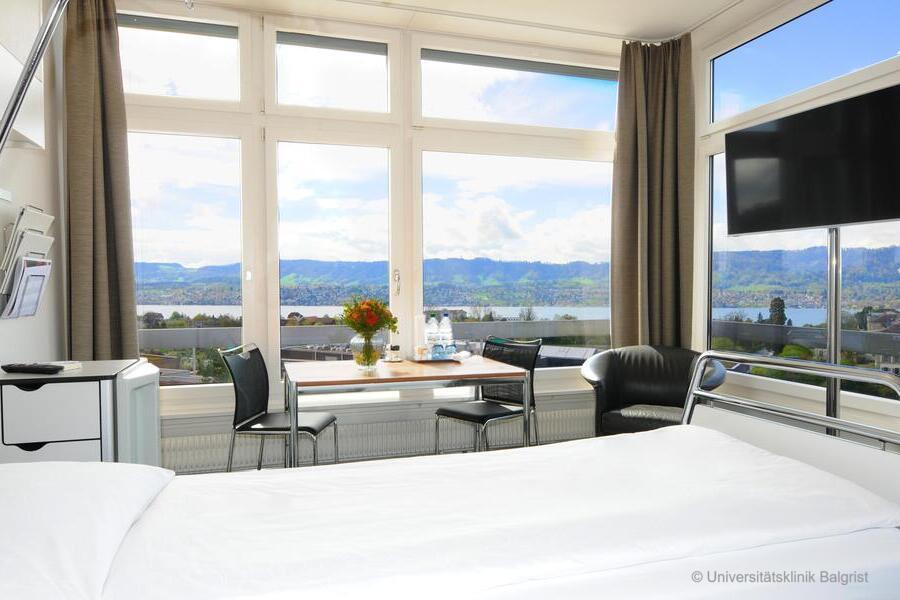Spine Specialist Zurich (Switzerland): Prof. Dr Mazda Farshad, MPH (FACS)
Treatment focus
- Degeneration and instability of the spine
- Disk herniations of the spine (lumbar spine, cervical and thoracic spine)
- Spinal canal stenosis
- Complex deformities of the spine in childhood and adulthood
- Tumors and inflammations of the spine
- Spinal column injuries
- Revision surgery of pre-operated spines
Medical Range
Range of Diagnostic Services
- Digital X-ray imaging of the spine
- EOS full-body X-ray scanner for whole spine imaging
- MRI examination
- CT examination
- Electrophysiology
- Bone density measurement with the possibility of simultaneous vertebral fracture risk assessment
- Myelography
Range of Therapeutic Services
- Consequences of deterioration of the spine (degeneration, instability, etc.)
- Complex deformities of the spine (children and adults)
- Pre-operated spine (revision surgery)
- Herniated disks and disk herniations of the lumbar spine
- Disk herniations of the cervical and thoracic spine
- Osteoporotic spinal diseases
- Spinal stenosis
- Spinal tumors
- Inflammations of the spine
- Spinal column injuries
- Second opinions
More Information
Card
Prof. Dr Mazda Farshad, is a medical expert in spine surgery. He is the director of the spine center and head physician of orthopedics and spine surgery at Balgrist University Hospital. In addition, he leads the clinic as a medical director.
The highly specialized team around Prof. Mazda Farshad operates on diseases and injuries of the spine using the latest surgical techniques. As a university spine surgery center, innovation, and scientific approach, as well as the implementation of the most up-to-date knowledge and techniques, are part of the standard. Special expertise lies in the performance of revision interventions of the spine and treatment of the most complex deformities.
Spine Center Zurich – Diagnostics and Therapy at an International Level
The University Spine Center Zurich is unique in Switzerland. Thanks to interdisciplinary collaboration and the expertise of various categories, back problems can be assessed holistically. Prof. Farshad and his specialized colleagues from radiology, neurology, rheumatology, pediatric orthopedics, and chiropractic decide as a team whether conservative treatment is possible, or surgery is necessary. In this way, the affected patients are treated where they are best cared for, given their condition.
Specialized Medical Professionals in Intervertebral Disk Surgery of the Lumbar, Thoracic and Cervical Spine
If the pain caused by a herniated disk can no longer be relieved with medication or physiotherapy, or if symptoms of loss of sensation occur, disk surgery should be considered. Disk surgery complications are very rare.
The intraoperative procedure on the lumbar spine is performed microscopically. The portion of the disk that presses on the nerve root is removed in a tissue-conserving procedure. If the surgery on the cervical spine is necessary, it may have to be carried out through the thorax. In the cervical spine area, surgery is performed from behind or the front, depending on the prolapse. If a cavity is created in the spine as a result of the removal, it is filled with the patient's bone or with foreign material (a so-called cage) and bone.
Spinal Canal Stenosis
Spinal canal stenosis is relatively common in elderly patients. In many cases, conservative therapy by using infiltrations or medication is sufficient. However, if the symptoms increase and the quality of life is significantly reduced due to pain, surgery is advisable even at an advanced age. Surgery relieves the nerves and leg pain improves in over 90% of the cases. The walking distance of the patients is significantly prolonged. The quality of life is noticeably improved. Occasionally, slight back pain remains, but the treated persons cope well with it, and it does not interfere too much with their daily routine.
Spinal Instability
Displacements of vertebras can be congenital, develop congenitally, occur after accidents, or result from degeneration. The result of this instability of the vertebras is pain and, in some cases, neurological deficits. When conservative measures are no longer successful, surgery is considered to reduce the displacement and stiffen the unstable vertebrae. The goal is a pain-free and resilient spine.
Spinal Fusion – Strict Indication Ensures Success
Stabilizing spinal surgery is only considered if the symptoms are severe to an extent where they can no longer be controlled with conservative methods. The quality of life must be severely limited, or nerve deficits must be present. With a strict selection of patients, a good result can be achieved in at least two-thirds of the cases, which means that patients no longer need to take pain medication and are able to resume work. In most cases, slight back pain remains, but most of the treated patients cope much better with their pain after spinal fusion than before.
Experienced Experts in Scoliosis Surgery
If the patient suffers from a curvature of the spine accompanied by lateral bending and twisting, this is called scoliosis, which can lead to spinal dysfunction and painful conditions. If surgical therapy is necessary, it is performed under general anesthesia. It is increasingly successful and safe due to modern intraoperative navigation and special neuro-monitoring.
Scoliosis surgery can significantly improve the curvature of the spine, and the clinic follows a holistic concept that includes not only a multimodal pain concept after surgery but also subsequent clinical and radiological follow-up examinations.
Identifying Spinal Tumors and Removing Them in the Best Possible Way
Most spinal tumors are benign and arise from the nerve sheaths (neurinomas) or the meninges (meningiomas). Malignant neoplasms within the spinal cord are rare. Primary bone tumors are very rare. In addition to a detailed neurological examination, magnetic resonance imaging with a contrast agent is the first-line tool for accurate tumor identification.
The goal of surgery is complete tumor removal to allow for the best possible therapeutic outcome. To avoid serious paralysis, the entire procedure is performed using a meticulous surgical technique under neuro-monitoring. In the case of tumors of the vertebral bodies, complete removal of the vertebral body by the surgeon is usually necessary, whereby the exact procedure depends on the type of tumor and its localization.
For more information, please visit the spine surgery website of the Balgrist University Hospital.
Curriculum Vitae
| 2001–2007 | Medical School, University Zurich, Switzerland |
| 2007–2008 | Assistant Physician, General and Trauma Surgery, Triemli Spital, Zurich, Switzerland |
| 2009–2012 | Training as "Physician-Scientist" in Orthopedic Surgery |
| 2012 | Assistant Physician, Orthopedic Surgery, Balgrist University Hospital, University of Zurich, Switzerland |
| 2021 | Specialist examination for Orthopedic Surgery and Traumatology |
| 2012–2013 | Clinical Spine/Scoliosis Fellow, Chief Spine Fellow, Hospital for Special Surgery, New York, USA |
| 2013–2014 | Medical Specialist, Orthopedic Surgery and Traumatology, University Hospital Geneva, Switzerland |
| 2014–2015 | Team Leader Spine Surgery, Balgrist University Hospital, University of Zurich, Switzerland |
| Since Sept. 2015 | Head of Spine Surgery, Balgrist University Hospital, University of Zurich, Switzerland |
| Since August 2017 | Medical Hospital Director, Balgrist University Hospital, University of Zurich, Switzerland |
Click here for more information about Prof. Dr med. Mazda Farshad, MPH (FACS).
Team
- PD Dr José Miguel Spirig
Consultant Spine Surgery, Representative Head of the University Spine Center - Dr Florian Wanivenhaus
Senior Physician mbf Spine Surgery - PD Dr M.Sc. Thorsten Jentzsch
Senior Physician mbf Spine Surgery, Head of the Location UWZH Kantonsspital Schaffhausen - PD Dr Christoph Laux
Senior Physician mbf Spine Surgery, Responsible Person for EuroSpine Center of Excellence - Dr David Bauer
Senior Physician Spine Surgery - Dr MAS MP Frédéric Cornaz
Senior Physician by Proxy, Spine Fellow - Dr Alexandra Stauffer
Senior Physician by Proxy, Spine Fellow - Dr Anna-Katharina Calek
Senior Physician by Proxy, Spine Fellow
Extras
- Rooms with TV, telephone, WLAN, view of Lake Zurich
- "Balgrist Café" restaurant and cafeteria
- Comprehensive service for national and international guests
- Post office, kiosk
- Patient service (including tea and beverage service and organizing overnight stays for guests)
- Room service (for privately and semi-privately insured patients)
Transport Connections
| Zurich Main Railroad Station | 4.6 km |
| Zurich Airport | 14 km |
| Basel Airport | 105 km |
| Bern-Belp Airport | 149 km |
| Geneva Airport | 288 km |
Information about Zurich
The capital of the canton of the same name is also the largest city in Switzerland. Geographically it is located north in eastern Switzerland. Zurich is situated on the Limmat River, directly at the outflow of Lake Zurich, and is thus also called the "Limmat City." Economically, socially and scientifically, Zurich is considered the center of Switzerland. Therefore, large banks, many media companies, and international companies are located there, and at the same time, the cultural offer is rich. The well-known Swiss Federal Institute of Technology Zurich (ETHZ) gives Zurich an international name in educational institutions.














